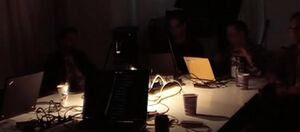Berlin Interpretation
"The Berlin Interpretation" refers to a specific definition agreed at a specific time and place. Please do not edit this article in a manner that changes the meaning behind the content.
This is not meant to discourage discussion of the interpretation or the definition of roguelikes, but to preserve this particular definition.
A popular interpretation of "What a Roguelike is" that was created at the International Roguelike Development Conference 2008. The interpretation is the product of a discussion between all who attended (including Ido Yehieli, Radomir Dopieralski and Jeff Lait). The 13 "roguelikeness factors" definition posted by Slash at Temple of the Roguelike at the moment as a "roguelike definition" (currently hosted here) was used as the starting point for the discussions.
The Berlin Interpretation was posted by Jeff Lait in rec.games.roguelike.development on September 16, 2008 (https://groups.google.com/g/rec.games.roguelike.development/c/Orq2_7HhMjI).
Original text
==Preamble== This definition of "Roguelike" was created at the International Roguelike Development Conference 2008 and is the product of a discussion between all who attended. The definition at http://www.roguetemple.com/roguelike-definition/ was used as the starting point for the discussions. Most factors are newly phrased, new factors have been added, some factors have been removed. ==General Principles== "Roguelike" refers to a genre, not merely "like-Rogue". The genre is represented by its canon. The canon for Roguelikes is ADOM, Angband, Crawl, Nethack, and Rogue. This list can be used to determine how roguelike a game is. Missing some points does not mean the game is not a roguelike. Likewise, possessing some points does not mean the game is a roguelike. The purpose of the definition is for the roguelike community to better understand what the community is studying. It is not to place constraints on developers or games. ==High value factors== ====Random environment generation==== The game world is randomly generated in a way that increases replayability. Appearance and placement of items is random. Appearance of monsters is fixed, their placement is random. Fixed content (plots or puzzles or vaults) removes randomness. ====Permadeath==== You are not expected to win the game with your first character. You start over from the first level when you die. (It is possible to save games but the savefile is deleted upon loading.) The random environment makes this enjoyable rather than punishing. ====Turn-based==== Each command corresponds to a single action/movement. The game is not sensitive to time, you can take your time to choose your action. ====Grid-based==== The world is represented by a uniform grid of tiles. Monsters (and the player) take up one tile, regardless of size. ====Non-modal==== Movement, battle and other actions take place in the same mode. Every action should be available at any point of the game. Violations to this are ADOM's overworld or Angand's and Crawl's shops. ====Complexity==== The game has enough complexity to allow several solutions to common goals. This is obtained by providing enough item/monster and item/item interactions and is strongly connected to having just one mode. ====Resource management==== You have to manage your limited resources (e.g. food, healing potions) and find uses for the resources you receive. ====Hack'n'slash==== Even though there can be much more to the game, killing lots of monsters is a very important part of a roguelike. The game is player- vs-world: there are no monster/monster relations (like enmities, or diplomacy). ====Exploration and discovery==== The game requires careful exploration of the dungeon levels and discovery of the usage of unidentified items. This has to be done anew every time the player starts a new game. ==Low value factors== ====Single player character==== The player controls a single character. The game is player-centric, the world is viewed through that one character and that character's death is the end of the game. ====Monsters are similar to players==== Rules that apply to the player apply to monsters as well. They have inventories, equipment, use items, cast spells etc. ====Tactical challenge==== You have to learn about the tactics before you can make any significant progress. This process repeats itself, i.e. early game knowledge is not enough to beat the late game. (Due to random environments and permanent death, roguelikes are challenging to new players.) The game's focus is on providing tactical challenges (as opposed to strategically working on the big picture, or solving puzzles). ====ASCII display==== The traditional display for roguelikes is to represent the tiled world by ASCII characters. ====Dungeons==== Roguelikes contain dungeons, such as levels composed of rooms and corridors. ====Numbers==== The numbers used to describe the character (hit points, attributes etc.) are deliberately shown.
Controversy
In his article "Screw the Berlin Interpretation!" Darren Grey accuses the Berlin Interpretation of being inaccurate, outdated, and unrepresentative of a vibrant and open genre. In particular, he ridicules features such as ASCII and Dungeons as being irrelevant to a genre that traditionally prioritizes gameplay mechanics over aesthetics or setting. He criticizes the common use of the Berlin Interpretation as the go-to roguelike definition.
In the wider gaming community the term roguelike or "with roguelike elements" is more popularly used to describe any game combining permadeath with procedural content. (See the articles in GiantBomb and Penny Arcade).
